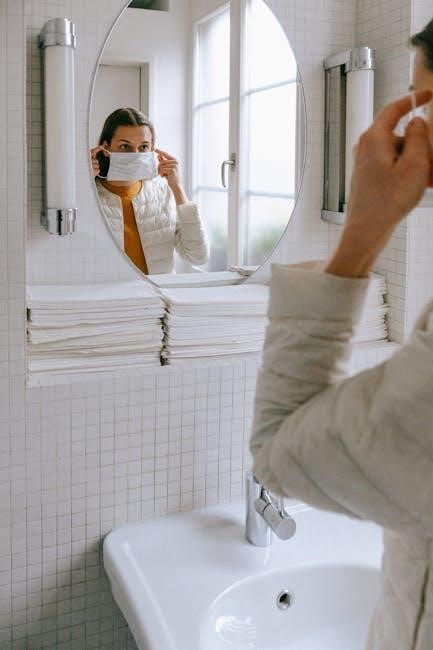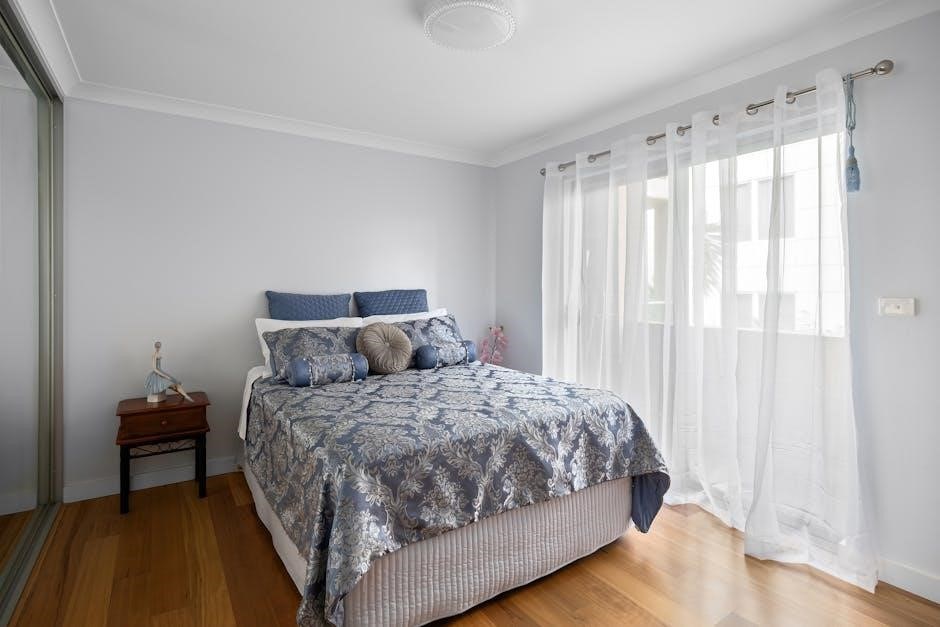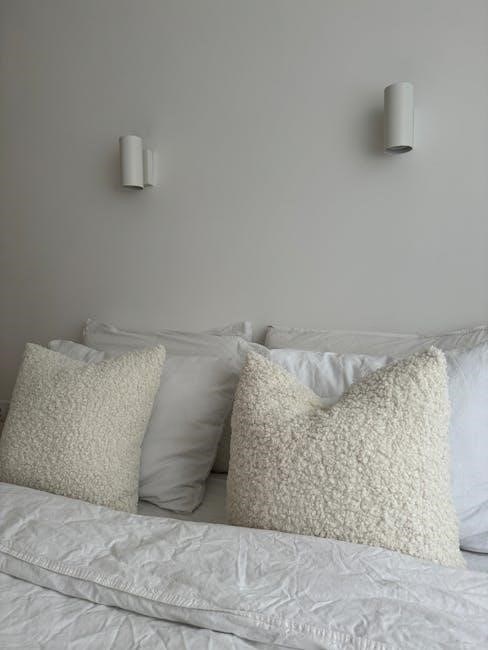oate duvet cover washing instructions
Oate duvet covers are known for their softness and breathability‚ making them a popular choice for bedding․ Proper washing techniques ensure their quality and longevity‚ maintaining comfort and hygiene․
1․1 Importance of Proper Washing Techniques
Proper washing techniques are essential to maintain the quality and longevity of oate duvet covers; Improper methods can lead to shrinkage‚ fading‚ or damage to the fabric․ Using the right water temperature‚ gentle cycles‚ and mild detergents ensures the fabric remains soft and breathable․ Regular washing prevents the buildup of dirt and odors‚ promoting hygiene and comfort․ Avoiding harsh chemicals and bleach preserves the fabric’s natural texture and color․ Following care instructions helps extend the life of the duvet cover‚ ensuring it continues to provide a cozy and fresh sleeping environment․ Proper washing also prevents damage from over-drying or excessive agitation‚ maintaining the cover’s shape and functionality․
1․2 Overview of Oate Fabric Characteristics
Oate fabric is renowned for its softness‚ breathability‚ and hypoallergenic properties‚ making it an excellent choice for bedding․ It is lightweight‚ durable‚ and naturally moisture-wicking‚ ensuring comfort in various climates․ The fabric’s smooth texture prevents irritation‚ ideal for sensitive skin․ Oate duvet covers are often crafted from high-quality materials that maintain their shape and color over time․ Their natural fibers allow for airflow‚ reducing the risk of overheating․ Additionally‚ oate fabric is resistant to dust mites and mildew‚ promoting a healthy sleep environment․ These characteristics make oate duvet covers both luxurious and practical‚ ensuring a restful and comfortable sleeping experience while being easy to care for with proper washing techniques․

Pre-Washing Preparation
Inspect the duvet cover for stains‚ remove loose dirt‚ and pre-treat spots to ensure effective cleaning․ This step prevents damage and maintains the fabric’s integrity during washing․
2․1 Checking Care Labels
Always begin by examining the care label on your oate duvet cover for specific washing instructions․ These labels provide essential guidance‚ such as recommended wash cycles‚ water temperatures‚ and suitable detergents․ Symbols or text may indicate whether hand washing‚ machine washing‚ or dry cleaning is advised․ Pay attention to maximum temperature settings‚ as oate fabric can be sensitive to heat․ Some labels may specify gentle or delicate cycles to preserve the fabric’s softness and texture․ Additionally‚ check for any bleach or fabric softener restrictions‚ as these can damage the material․ Adhering to the care label ensures the duvet cover remains in optimal condition and prevents shrinkage or color fading․ Ignoring these guidelines can lead to irreversible damage‚ so careful review is crucial before proceeding․
2․2 Removing Loose Dirt and Stains
Before washing your oate duvet cover‚ inspect it for any loose dirt or stains․ Gently brush off loose particles using a soft-bristle brush to prevent snagging the fabric․ For stains‚ dampen a clean cloth with cold water and blot the area gently without rubbing‚ as friction can damage the oate material․ Avoid using harsh chemicals or abrasive cleaners‚ as they may weaken the fabric․ If stains persist‚ consider pre-treating with a mild detergent specifically designed for delicate fabrics․ Allow the solution to sit for a few minutes before rinsing․ Always test a small‚ inconspicuous area first to ensure the treatment doesn’t discolor the fabric․ Promptly addressing stains helps maintain the duvet cover’s appearance and prevents stubborn marks from setting in․
2․3 Pre-Treating Stains and Spots
Pre-treating stains on your oate duvet cover is essential to ensure effective removal without damaging the fabric․ Start by examining the care label for specific recommendations․ For most stains‚ apply a small amount of mild detergent directly to the affected area․ Gently massage the detergent into the fabric using a soft cloth or your fingertips‚ working from the outside of the stain inward․ Avoid using harsh chemicals‚ bleach‚ or fabric softeners‚ as these can harm the oate material․ Let the detergent sit for about 10–15 minutes to penetrate the stain․ Rinse the treated area with cold water before washing the duvet cover as usual․ This method helps prevent stains from setting in and maintains the fabric’s softness and integrity․

Washing Machine Setup
Set your washing machine to a gentle cycle with cool or warm water․ Use a mild detergent‚ avoiding harsh chemicals․ Wash oate duvet covers separately to prevent damage․
3․1 Choosing the Right Cycle

When washing an oate duvet cover‚ selecting the right cycle is crucial․ Opt for a gentle or delicate cycle to protect the fabric from damage․ A cool or warm water setting is recommended to prevent shrinkage and maintain the fabric’s softness․ Avoid using harsh or intense cycles‚ as they can cause fiber breakdown or misshapen covers․ For best results‚ ensure the cycle includes a slow agitation setting to minimize wear on the material․ Always check the care label for specific cycle recommendations‚ as some oate fabrics may require special handling․ Proper cycle selection ensures the duvet cover remains comfortable‚ breathable‚ and retains its original texture after washing․
3․2 Selecting the Appropriate Water Temperature
Selecting the right water temperature is essential for washing oate duvet covers․ Use cool or warm water‚ as hot water can shrink or damage the fabric․ Cool water preserves the fabric’s softness and breathability‚ while warm water helps remove dirt without causing harm․ Avoid hot water‚ as it can weaken fibers and lead to a misshapen cover․ For tougher stains‚ a slightly warmer temperature may be necessary‚ but ensure it doesn’t exceed 60°C or 140°F․ Always check the care label for specific temperature recommendations․ Proper temperature selection maintains the duvet cover’s quality and ensures it remains comfortable and durable after washing․
3․3 Adding Mild Detergent
Using a mild detergent is crucial when washing oate duvet covers to preserve their softness and prevent damage․ Choose a gentle‚ non-toxic detergent free from harsh chemicals‚ bleach‚ or fabric softeners‚ as these can weaken fibers and reduce breathability․ For best results‚ opt for a liquid detergent without optical brighteners‚ as they can affect fabric texture․ Measure the detergent according to the manufacturer’s guidelines to avoid overuse‚ which can leave residue on the fabric․ Avoid using regular laundry detergents designed for heavier soiling‚ as they may be too harsh for delicate oate fabric․ Mild detergents ensure a clean wash while maintaining the duvet cover’s natural qualities and extending its lifespan․

Special Washing Tips
For optimal results‚ add tennis balls to maintain fluffiness‚ avoid harsh chemicals‚ and wash separately to prevent damage․ These tips ensure fabric integrity and longevity․
4․1 Adding Tennis Balls for Fluffing

Add tennis balls to your washer during the cycle to maintain the duvet cover’s fluffiness and prevent clumping․ This simple trick ensures the fabric remains soft and lofty․
Use 2-3 clean‚ new tennis balls for optimal results․ They gently agitate the fabric‚ redistributing filling evenly without causing damage or stretching the material․
Ensure the balls are clean to avoid transferring dirt or odors․ This method is especially effective for down or feather-filled covers‚ preserving their shape and comfort over time․
Avoid using fabric softeners‚ as they can weigh down the fabric․ Instead‚ rely on the tennis balls to keep your duvet cover light‚ airy‚ and freshly maintained․
4․2 Avoiding Harsh Chemicals and Bleach
Harsh chemicals and bleach can damage oate duvet covers by weakening fibers and causing discoloration․ These chemicals can break down the fabric’s natural softness and breathability‚ leading to a rough texture and reduced durability․
Opt for mild‚ gentle detergents specifically designed for delicate or natural fabrics․ Avoid fabric softeners‚ as they can leave a residue that affects the fabric’s performance and feel․
For tough stains‚ pre-treat with a small amount of mild detergent or a natural alternative like white vinegar․ This approach ensures the fabric remains intact while effectively removing stains․
By avoiding harsh chemicals‚ you preserve the duvet cover’s quality‚ ensuring it remains soft‚ comfortable‚ and long-lasting for years to come․
4․3 Washing Separately from Other Fabrics
Washing your oate duvet cover separately from other fabrics is essential to maintain its quality and prevent damage․ Other fabrics‚ especially those with buttons or zippers‚ can cause friction during washing‚ leading to pilling or snagging of the delicate oate material․
Additionally‚ washing separately ensures that the duvet cover is not exposed to dyes or lint from other fabrics‚ which could affect its appearance or texture․ This is particularly important for colored or patterned oate covers‚ as cross-dyeing can occur in mixed loads․
By washing the duvet cover alone‚ you ensure a gentler cycle and prevent potential damage from heavier or coarser fabrics․ This practice helps preserve the softness‚ breathability‚ and overall longevity of the oate fabric․

Drying Instructions
For optimal results‚ air dry your oate duvet cover or tumble dry on a low-heat setting․ Fluffing during drying helps maintain loft and softness․
5․1 Air Drying vs․ Tumble Drying
Air drying is the preferred method for oate duvet covers to preserve their softness and texture․ Lay the cover flat or hang it to ensure even drying․ Tumble drying is an alternative but should be done on a low-heat setting to prevent shrinkage or damage․ Remove the duvet cover immediately after the cycle to avoid wrinkles․ For optimal results‚ fluff the cover during drying to maintain its loft and softness․ Both methods require careful attention to prevent overheating‚ which can harm the fabric․ Proper drying ensures the duvet cover remains breathable and comfortable for extended use․
5․2 Using Low Heat in the Tumble Dryer
When tumble drying your oate duvet cover‚ always use a low-heat setting to protect the fabric from damage․ High heat can shrink the material or cause it to lose its softness․ Set the dryer to a temperature of around 60°C (140°F) to ensure gentle drying․ This setting is ideal for preserving the fabric’s integrity and maintaining its breathability․ Avoid leaving the duvet cover in the dryer for extended periods‚ as this can lead to unnecessary wear․ Once the cycle is complete‚ remove the cover promptly to prevent wrinkles and ensure it remains smooth and comfortable․ Low heat helps maintain the fabric’s natural texture and prevents damage during the drying process․
5․3 Fluffing the Duvet Cover During Drying

Fluffing your oate duvet cover during the drying process is essential to restore its natural loft and prevent it from becoming flat or misshapen․ If air drying‚ gently shake the cover to redistribute the fabric and ensure even drying․ For tumble drying‚ remove the cover while it’s still slightly damp and fluff it thoroughly to prevent clumping․ This step helps maintain the softness and breathability of the fabric․ Regular fluffing also ensures the duvet cover retains its shape and remains comfortable for use․ By incorporating this simple step into your drying routine‚ you can extend the lifespan of your oate duvet cover and keep it looking its best․ Fluffing is a quick and effective way to preserve the quality of your bedding․

Maintenance and Care
Regular maintenance and proper care are essential to preserve the quality of your oate duvet cover․ Proper storage and cleaning techniques help maintain its softness and breathability over time․
6․1 Recommended Washing Frequency
It is generally recommended to wash your oate duvet cover every 1 to 3 months‚ depending on usage and personal hygiene preferences․ Factors such as sweat accumulation‚ climate‚ and whether a top sheet is used can influence this frequency․ In warmer climates or for individuals who sweat more‚ washing every month may be advisable․ Conversely‚ in cooler environments‚ every 2 to 3 months could suffice․ Always check the care label for specific instructions‚ as some fabrics may require different care․ Balancing regular washing with gentle care ensures the duvet cover remains hygienic and maintains its softness and breathability over time;
6․2 Proper Storage to Prevent Damage
Proper storage is essential to maintain the quality and longevity of your oate duvet cover․ Store it in a cool‚ dry place away from direct sunlight to prevent fading or damage․ Use a breathable storage bag‚ such as one made of cotton or mesh‚ to allow airflow and prevent moisture buildup․ Avoid using plastic bags‚ as they can trap humidity and lead to mildew․ Fold or hang the duvet cover neatly to avoid creases and wrinkles․ Ensure the cover is completely clean and dry before storing‚ as residual moisture can cause damage over time․ Proper storage helps preserve the fabric’s softness‚ breathability‚ and overall integrity‚ ensuring it remains in excellent condition for future use․
6․3 Refreshing Without Washing
Refreshing your oate duvet cover without washing is a great way to maintain its quality between washes․ Start by airing it out in a well-ventilated area to eliminate odors naturally․ For a fresh scent‚ lightly spritz with a mixture of water and a few drops of mild essential oil‚ such as lavender․ Spot clean any stains with a damp cloth to prevent them from setting․ Avoid using fabric softeners or harsh chemicals‚ as they can damage the fabric over time․ Regular refreshing helps maintain the duvet cover’s softness and breathability while extending the time between full washes․ This method is gentle on the fabric and keeps it feeling clean and fresh․

Troubleshooting Common Issues
Addressing common issues like odors‚ shrinkage‚ or fabric softening ensures your oate duvet cover remains in optimal condition․ Use natural odor removers‚ reshape after washing to prevent shrinkage‚ and avoid fabric softeners to maintain its texture and breathability․
7․1 Removing Odors Naturally
Removing odors from oate duvet covers can be done naturally without harsh chemicals․ Add a cup of white vinegar to the wash cycle to neutralize odors․ For persistent smells‚ sprinkle baking soda directly on the cover before washing․ Essential oils like lavender or tea tree can also be added to the rinse cycle for a fresh scent․ Avoid using bleach‚ as it can damage the fabric․ Sunlight is another natural odor remover—hang the duvet cover outside to air out․ These methods are gentle on the fabric and ensure the cover remains soft and breathable while eliminating unwanted odors effectively․
7․2 Fixing Shrinkage or Misshapen Covers
If your oate duvet cover has shrunk or become misshapen after washing‚ there are steps to restore its shape․ First‚ avoid hot water‚ as it can cause fibers to contract․ Gently stretch the cover back into shape while it’s still damp‚ focusing on areas that appear tight․ Lay it flat to air dry‚ smoothing out wrinkles as it dries․ For severe shrinkage‚ soak the cover in cold water with a mild detergent‚ then carefully reshape it․ Avoid machine drying‚ as heat can worsen the issue․ Proper drying and reshaping can help restore the cover’s original dimensions and appearance‚ ensuring it fits your duvet smoothly once again․
7․3 Dealing with Fabric Softening
For oate duvet covers‚ fabric softening should be approached with care․ Natural fibers like oate are inherently soft‚ so fabric softeners may not be necessary and can leave a residue that reduces breathability․ If you prefer a softer texture‚ consider using a small amount of vinegar during the rinse cycle to naturally soften the fabric without chemicals․ Avoid fabric softening sheets‚ as they can coat the fibers and affect their natural feel․ Air drying is also recommended‚ as heat from dryers can stiffen the fabric over time․ Proper washing and drying techniques will help maintain the softness and integrity of your oate duvet cover‚ ensuring it remains comfortable and durable for years to come․
Proper washing and care of oate duvet covers ensure their softness‚ breathability‚ and longevity․ Following gentle cycles‚ mild detergents‚ and air drying maintains their quality and comfort effectively․
8․1 Summary of Best Practices
To maintain the quality and longevity of your oate duvet cover‚ adhere to these best practices: Always check the care label for specific instructions․ Use a gentle washing cycle with cold or warm water‚ and opt for a mild detergent to preserve the fabric․ Avoid harsh chemicals‚ bleach‚ or fabric softeners‚ as they can damage the material․ Gently remove stains before washing and avoid over-drying‚ as this can cause shrinkage or discomfort․ For drying‚ air drying is recommended‚ but if using a tumble dryer‚ select a low-heat setting․ Regular washing every 2-3 months is ideal to maintain hygiene․ Proper storage and refreshing methods can extend the life of your duvet cover‚ ensuring it remains soft and breathable for years․
8․2 Ensuring Longevity of Oate Duvet Covers
To ensure the longevity of your oate duvet cover‚ adopt a few simple care practices․ Wash it in a gentle cycle with mild detergent to prevent fabric wear․ Avoid using bleach or harsh chemicals‚ as they can weaken the material․ After washing‚ air-dry the cover or tumble dry on a low-heat setting to avoid shrinkage․ Store the duvet cover in a cool‚ dry place when not in use to prevent moisture damage․ Regular washing every 2-3 months helps maintain hygiene without over-washing‚ which can degrade the fabric․ By following these care tips‚ your oate duvet cover will remain soft‚ breathable‚ and comfortable for years to come․

